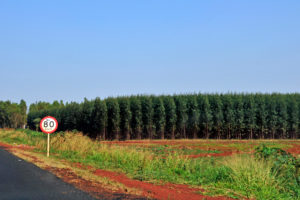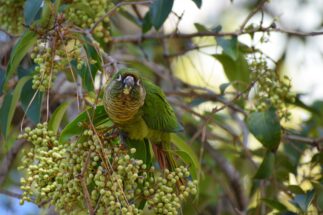The world is increasingly hearing a simple mantra for mitigating the climate crisis: plant trees. Forests are our largest terrestrial sinks for carbon dioxide, the primary greenhouse gas driving global heating. In 2018, the United Nations’ Intergovernmental Panel on Climate Change stated that significant afforestation can contribute to efforts to limit global average temperature rise to 1.5C. Hundreds of millions of hectares of new trees would be needed for this.
South America is among the world’s leading regions in plantation forestry, with the second largest area of tree plantations globally, behind only Asia, concentrated in Brazil, Argentina, Chile and Uruguay. However, even though 15% of the world’s approximately 131 million hectares of tree plantations are in South America, they have neither helped to solve the region’s deforestation problems, nor proven greatly effective in reducing greenhouse gas emissions.
This is because South America’s tree plantations are almost exclusively for industry and are, in most cases, based around pine or eucalyptus monocultures. These plantations consist of a single species growing across an expansive area, accelerated by fertiliser and pesticide use. Monocultures do not facilitate biodiversity, which limits their capacity for carbon sequestration. Such practices promote soil degradation and the destruction of naturally occurring, native vegetation.
“These monocultures do not recover carbon in the same way as natural secondary forests,” explains Carlos Nobre, an earth system scientist at the University of Sao Paulo’s Institute of Advanced Studies, and a leading researcher on forestry issues in Brazil. “They can remove some [carbon], but they don’t promote biodiversity because they are exotic species.”
Millions of hectares of exotic species
In South America, 97% of forest plantations are composed of exotic, introduced species, mainly pine and eucalyptus, used primarily for timber and pulp, respectively. Brazil, Argentina, Uruguay and Chile are home to some of region’s largest planted areas, and during the past century, all four countries introduced these species to develop their paper and timber industries, aided by government grants and initiatives to promote their use.
Mauricio Aguilera, a forestry engineer from Chile, tells Diálogo Chino that tree plantations emerged in his country to combat erosion caused by agriculture and pre-1950 burning of native vegetation. This evolved into the industrialised production of mostly pine and eucalyptus. Similar processes took place in other countries, experts told Diálogo Chino, with planting frequently taking place on degraded land. Rapid growth in forestry was seen, and over decades the sector continued to grow ever larger.
Today, about 16.8 million hectares of forest plantations are spread across Brazil (accounting for 67% of this area), Chile (19%), Argentina and Uruguay (7.1% each). The fast-growing Eucalyptus globulus has proliferated in the region and its forestry sectors: eucalyptus plantations for pulp production predominate in all these countries but Chile, where pine is dominant.
According to Hivy Ortiz, who develops sustainable and resilient regional agriculture initiatives in Latin America and the Caribbean for the UN’s Food and Agriculture Organization, the landscape of the region’s forestry industry has changed over the years. “Plantation programmes were originally associated with forestry incentives. Now they are mostly private investments,” he tells Diálogo Chino.
According to a World Bank report, in 2021, half of Latin America’s entire forestry exports went to the United States (28.6%) and China (23.2%). The other half is distributed among 204 countries and territories. Most of this forestry industry is backed by a combination of national and international capital.
“In their places of origin, pine and eucalyptus can take up to 28 years to grow, because they are in more arid places or at latitudes closer to the poles, but in most of South America it takes four times less, which is why planting here is so attractive,” explains Mónica Bedoya, an environmental administrator at the Technological University of Pereira in Colombia.
What are the impacts of tree plantations?
During the past decade, scientists and organisations have warned of problems linked to pine and eucalyptus plantations displacing native forests. Consequences include facilitating the spread of diseases and fires, while consuming large amounts of water and harming biodiversity levels. On that final issue, Bedoya can testify: “On these plots of land only [the tree crop] grows. You are underneath and nothing else grows.”
The Salesian Polytechnic University of Ecuador reports that encroaching pine and eucalyptus plantations can compromise areas of high biodiversity. This is because they accelerate local water stress and change soils through, for example, salinisation and acidification.
In Brazil, eucalyptus plantations are closely associated with soil degradation in its southern Atlantic Forest. Paulo Amaral, a forestry engineer at conservation group Imazon, estimates that only 6% of the biome’s native forest remains.
According to Aguilera, the industry’s focus is on efficiency: reforesting the same land, planting more trees, at a faster rate and in smaller spaces.
Aguilera says this efficiency has made it possible to reduce certain impacts of tree plantations, but damage to water and soil still occurs: “They may have dried up streams and the drinking water of some people who live in the countryside. Possibly because they were planted at a very high density, because they are located near water sources.”
Aguilera adds that the high density of plantations can also promote forest fires. While this is a natural process for pine trees, such high tree density can cause havoc, as demonstrated by the devastating fires seen in Chile in 2017 and 2023.
Can there be environmental benefits?
In Chile, some forestry experts point out that tree plantations can reduce the threat of deforestation to native forests. “If it weren’t for these plantations with exotic species, we would have far fewer primary forests,” says Chilean forestry engineer Edison García Rivas.
Chile, unlike Brazil, has a more limited territory. Plantations are therefore located between mountain ranges, making up one fifth of Chile’s forest cover. Since subsidies to the industry were eliminated in 2012, the expansion of plantations into native forests has fallen substantially.
This is also the case in Uruguay. The country’s national forestry director, Carlos Faroppa, tells Diálogo Chino that Uruguay has had zero deforestation “for years”. This, he explains, is because the country’s original vegetation never consisted of much forest cover, with various types of grassland predominating, and also because of “the series of regulations that the government has been implementing for years”. Faroppa refers to export measures and certifications that support sustainable production management.
Something that needs to be done at the management level is land-use planningAna Di Pangracio, FARN
In Brazil and Argentina, plantations do not yet play a beneficial role in forest protection, although some experts do not rule out the possibility. Paulo Amaral concedes that tree plantations in the Amazon could protect soils during the initial stages of their growth, “but never in the long-term”.
Ana Di Pangracio, from the Environment and Natural Resources Foundation (FARN) in Argentina, says forestry activities should be better regulated and the planting of native trees encouraged: “In Argentina, and I’m sure in the rest of the region, something that needs to be done at the management level is land-use planning.”
Ortiz does not consider tree plantations to be especially detrimental to the environment, but like Pangracio, he advocates for careful planning: Industrial forestry, he says, “has the main function of reducing the threat to native forests, as long as it is done in a controlled and managed way, without cutting down native forest to put in plantations.”
Restoration plans
There have been incipient projects aimed at restoring native forests in South America for more than a decade. Most of them entail removing incentives for industries like forestry and proposing new regulatory frameworks that enable restoration. Common restoration strategies include combining tree planting with other production through agroforestry, the protection of specific forest areas and, in highly disturbed areas, the replanting of native vegetation.
Brazil, Chile and Uruguay no longer subsidise the forestry industry, and Chile is also moving towards mixed agricultural and forestry production. Daniela Manuschevich, head of species and biodiversity at Chile’s environment ministry, elaborates: “Multifunctional plantations aim to conserve and produce both timber and non-timber forest products, such as mushrooms and berries.” This replacement of monocultures aids soil restoration, which boosts natural carbon sequestration rates.
In terms of reforestation initiatives, one of the most emblematic examples is Re.green in Brazil, which aims to restore 1 million hectares of land in the Amazon and Atlantic forests. According to Rodrigo Rodrigues, a researcher at the University of Sao Paulo, this is one of the most ambitious projects contributing to Brazil’s zero deforestation goals.
In the context of climate change, multifunctional and diverse forests provide us with insurance, a possibility that the impacts will not be so severeDaniela Manuschevich, head of species and biodiversity at Chile’s environment ministry
Some of Latin America’s reforestation efforts are large, state-managed initiatives, funded by either the state or environmental funds like the Global Environment Facility and the Green Climate Fund. Brazil, Chile, Uruguay and Argentina each have smaller-scale projects, too, mainly financed by private companies. Nobre highlights the example of Vale, the Brazilian iron ore mining company, which has reportedly pledged to recover and protect 500,000 hectares by 2030.
Where deforestation continues and degraded soils become increasingly impermeable, Manuschevich says the consequences for human settlements can be “catastrophic”. She concludes with a simple mission statement: “In the context of climate change, be it extreme rainfall or drought, multifunctional and diverse forests provide us with insurance, a possibility that the impacts will not be so severe.”









